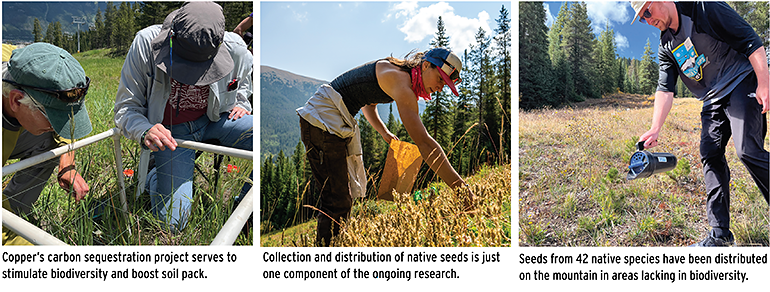An ongoing carbon sequestration research project at Copper Mountain Resort, Colo., is expected to offer a wide range of environmental benefits, with low overhead and upfront costs.
The project, begun two years ago, tests various mechanisms to fortify the soil pack in disturbed areas around the resort. The goal is to stimulate natural biodiversity to help the terrain absorb as much carbon from the atmosphere as possible. While its efficacy as a carbon sink won’t be quantified until the work is further along and data can be collected, the ramifications of the project extend beyond sequestration and are important on a local level, according to Copper’s senior resort operations and sustainability manager, Jeff Grasser.
“There’s a lot of effort in our industry to work on that global conservation piece, but there’s not enough effort, in my opinion as an ecologist, to take on that local piece,” says Grasser. This project, he says, aims to address the question of “How we can make sure this ecosystem at Copper stays intact through the next 100 years of anthropogenic climate change so it can be part of the solution and also remain a really important place for people to experience nature.”
The project has several components: seed collection and distribution; the enrichment of existing soil pack around disturbed plots; and soil monitoring.
Through it, Copper has collected seeds from 42 native species, formulated them into a biodiverse mix, and is distributing them throughout on-mountain areas that are lacking in biodiversity. Grasser and a handful of Copper employees have spearheaded the seeding, working alongside teams of mostly volunteers, including students from Southwestern University, local nonprofits, and corporate partners. At the 51-year-old Copper, there’s a visible need for the project.

“We can walk down a ski slope in the summertime to see that there is a high level of disturbance on our slopes,” says Grasser of the ski area. “This is where we believe we can take action and support biodiversity.”
Targets for restoration also include construction zones and places that have undergone recent maintenance.
While seed collection is the largest component of the project, the soil pack requires fortification as well. So, compost sourced from Summit County is being added to the soil as needed. After an initial analysis, the fortified soil will be evaluated in two five-year increments to measure factors like species composition, above- and below-ground vegetation mass, carbon levels, soil temperature, and moisture levels.
The project cost is relatively low. “My largest category of expense in this whole program (putting lab costs for soil testing aside) is the lunch I always buy for the volunteer participants,” says Grasser. “Those are the only substantial costs.”
That small investment is expected to provide big returns. In addition to its potential to reduce carbon emissions in the atmosphere, the project brings improved resistance to erosion, increased water retention, and support for wildlife. And that, Grasser says, makes it an investment in the future.
“Biodiversity is nature’s insurance policy against change,” he says. “It is an investment in the long-term viability of Copper’s business and our guests’ ability to experience nature while skiing and snowboarding, hiking, biking, and enjoying their time in nature.”
The implications extend beyond Copper, too. The science behind the project can be applied anywhere. “All around us in all different places, ecosystems have been degraded,” says Grasser. “Whether that’s a national forest, or a field, or an empty lot in an urban environment, we have the opportunity to [sink] carbon all over the place. And we can do that using natural mechanisms.”






